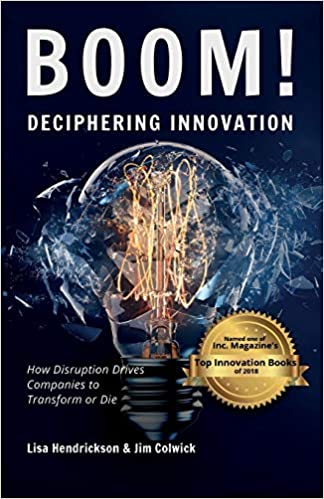
Innovation is a paradigm shift, said Lisa Hendrickson, co-author of Boom! Deciphering Innovation: How Disruption Drives Companies to Transform or Die.
For example, Apple’s iPhone didn’t just improve on telecommunications and the flip phone, but it altered how many people work and communicate altogether, Hendrickson said.
“It was the starting of the unbundling of the office that you could actually leave and accomplish things regardless of where you were,” Hendrickson said. “That was the kind of paradigm shift that allows us to say I don’t want to go back to doing it the old way.”
And it opens a different door than just getting better, Hendrickson said recently on the Ideas to Invoices podcast.
“We could have made a better and better flip phone and I’m sure people have actually worked on that and designed that to make that phone better and better but what really happened with innovation is we started really unpacking what does an untethered office look like,” Hendrickson said. “And that’s how the iPhone innovated.”
Why are some companies like Uber and Netflix good at innovating and some companies like Kodak, Blackberry, and Motorola bad at it?
Innovation is a mindset and it’s a foundation for how we see the world, Hendrickson said.
Companies that are successful see where the market is moving and they continue that path of innovation, Hendrickson said.
Incumbents often must protect what they have because of shareholder demands about holding onto market share and it’s a different conversation, Hendrickson said. The best way for incumbents to innovate is to set up an innovation lab with a gated environment away from existing operations, she said.

In her book, Hendrickson mentions that 88 percent of the Fortune 500 firms in 1955 vs. 2014 are gone and we’re all better off because of that dynamic creative destruction. Others like IBM and General Electric have lasted because they are better at adapting to change.
“In some parts of their business they have been able to be very forward-thinking and say times are changing we have to be able to innovate,” Hendrickson said.
When paradigm shifts happen, the market simply doesn’t need some things any long like transistors and rotary phones, Hendrickson said.
In the book, Hendrickson recounts how Nokia started out as a rubber boot maker and Marriott started as a Root Beer stand. Those are some incredible transformations over the years. Being innovative means not only adapting to change but persevering over the years and outlasting competitors and challengers.
“One of the things we can’t forget is that resources are going to allow us to go through the fallow periods to be able to move into a new innovative space,” Hendrickson said. “If you are undercapitalized you are not going to be able to do that work of transforming the company.”
The pace of change is happening faster and faster now, Hendrickson said. And the Internet of Things, Artificial Intelligence, Augmented Reality, Big Data, Blockchain, Virtual Reality, Social Media, are all converging.
“The plan is not necessarily about all the different ways you can innovate; it’s about changing the ways what the business sees as a core activity like R&D,” Hendrickson said. “Being able to have an innovation lab that works ongoingly.”
For more, listen to the entire podcast, pasted below, or wherever you get your podcasts – available on Google play store, Apple iTunes, Spotify, PlayerFM, Libsyn, and more.
